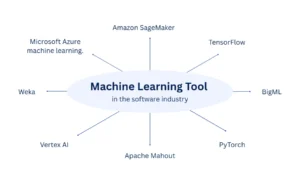The globe is no longer run on data but by smarts. From the apps we use daily to the algorithms predicting business trends, machine learning tools are quietly running the show. They do not passively process information; they learn, evolve, and change in each interaction, changing the way industries innovate and function.
As the demand for AI development tools and open-source ML platforms continues to rise, organizations are redefining how they innovate and compete. Whether it’s building smarter applications with Python machine learning libraries, deploying models using cloud-based machine learning tools, or implementing intelligent machine learning solutions, the potential of machine learning is expanding across industries.
As we step into 2025, understanding the best machine learning software and Top ML frameworks 2025 isn’t just beneficial — it’s essential. The blog covers the basics of machine learning, its core aspects, as well as the sophisticated resources remaking automation, precision, and creativity in the fields.
Learning about Machine Learning and Its Fundamentals
The modern intelligent systems are powered by machine learning. It enables machines to learn automatically and improve through data without having to be manually coded. Modern machine learning tools help computers analyze data, identify trends, and make predictions based on learned experiences.
These tools are updated through the analysis of trends in information, be it a text, an image, or sensor data, rather than adherence to rigid rules. Over time, they adapt their actions and improve outcomes autonomously, making machine learning tools essential for businesses relying on data-driven decisions.
Essential Components That Power Machine Learning Tools
1. Data — The Fuel for Learning
Data forms the backbone of all machine learning frameworks. Without it, even the best machine learning software cannot function. Data can exist in many forms—text, images, videos, or IoT sensor readings—and it guides the model in recognizing useful patterns.
2. Models — The Mathematical Core
A model in machine learning represents how real-world processes behave. Machine learning tools and AI development tools use these models to analyze and replicate patterns, continuously fine-tuning parameters for better accuracy.
3. Algorithms — The Brains Behind the Operation
Algorithms are the logic engines that train the models. They help reduce the gap between predictions and actual results. From Python machine learning libraries like TensorFlow and PyTorch to open-source ML platforms, algorithms form the foundation of intelligent model training.
4. Evaluation — Measuring Model Effectiveness
Once models are trained, they need to be evaluated. The process includes testing accuracy, precision, recall, and F1 score—depending on whether the task involves regression or classification. Advanced ML model deployment platforms simplify this process, ensuring models perform well across different environments.
Learning the Major Types of Machine Learning
Supervised Learning
In supervised learning, machine learning tools are trained on labeled datasets, learning from examples to predict outcomes accurately. It is also commonly applied in spam filtering or sales prediction.
Unsupervised Learning
In this case, an algorithm tries to find some hidden pattern or understanding through unstructured data with no labels attached. Many cloud-based machine learning tools leverage this method for data clustering and segmentation.
Semi-supervised Learning
This is a hybrid approach that involves both limited labeled data and substantial amounts of unlabeled data, which saves time and cost of manual labeling and provides better precision.
Reinforcement Learning
Reinforcement learning is a type of learning that allows an algorithm to learn and approach learning based on trial and error, just like a human being. It’s widely used in robotics, gaming, and recommendation systems–making it one of the most dynamic deep learning tools today.
Why Innovation of Tomorrow Will Be Characterized by Machine Learning Instruments
The machine learning software has been a source of technological development. The software assists businesses in making quicker, smarter, and data-driven choices by automating their operations and creating intelligent information, used for informed decisions. The ability to process large amounts of data, provide personalized user experiences, and automate everyday work explains why machine learning software is a necessity across all industry sectors.
Let’s explore how these AI development tools are changing modern business processes.
Transforming Data into Intelligence for Action
With growing data expanding exponentially, institutions rely on open-source ML platforms and cloud machine learning tools to quickly make sense of large datasets. Such systems detect latent trends, predict outcomes, and provide insights, which are hard to recognize unaided by machine efforts. With analytical ability and automation, it is now possible for systems to create real-time, actionable intelligence by converting the raw data into intelligible intelligence.
Automation of Operations
These automation processes are one of the key benefits of machine learning software programs. Their automation of complex processes is what banking, retail, and logistics industries rely on for making autonomous decisions, eliminating human interference, and increasing productivity overall. It helps keep the cost of operation low through automation, however, it also causes teams to focus less on doing things repetitively.
Personalizations of User Experiences
Modern companies need personalization, and machine learning software is its foundation. Whether it’s e-commerce sites recommending products, customizing the contents of a stream service, it’s all about observing how customers behave to deliver hyper-personalized experiences. That’s the ability to learn and predict what the user is going to want, and it’s going to help the brands build loyalty and long-term engagement.
Stimulating Change and Competitiveness
Companies embracing the greatest machine learning software are ahead of the times. With the deployment of Top ML frameworks 2025, businesses are better placed to create and run smart models at a faster pace, try new things, and tune performance with adaptable ML model run-time platforms. Such adaptability provides them a sustainable advantage when it comes to competition in the dynamic market.
Hard Questions of Different Industries
The real strength of machine learning technologies is their potential to solve things outside of a human’s capacity. It may be being able to forecast epidemics in healthcare, stock management in manufacturing, or weather prediction, but all of these are dramatically changing things. Collaboration between a seasoned AI development firm guarantees proper protocols, software, and know-how are being used to achieve meaningful results.

8 Best Machine Learning Tools
With the increasing use of AI by organizations in their business practices, the necessity for advanced machine learning tools has grown several fold. The platforms enable data scientists and coders to develop, train, and deploy intelligent systems more quickly and effectively. From scalable cloud-based machine learning platforms to adaptable open-source ML platforms, organizations now have access to a range of frameworks that cater to every level of complexity and use.
Let’s explore the Top ML frameworks 2025 redefining how companies handle AI-driven innovation.
1. Microsoft Azure machine learning
Microsoft Azure Machine Learning is among the most powerful cloud-based machine learning platforms, providing data scientists and developers with ease of creating, training, and deploying ML projects. The platform facilitates rapid project delivery and has incorporated MLOps, open source, and robust governance.
Key Highlights:
- Data Preparation Process large data fast with Apache Spark and with Azure Databricks.
- Web-Based: Hooks: Develop from Jupyter Notebooks or Visual Studio Code.
- Drag-and-Drop Design: A no-code visual designer that can be used to build ML pipelines fast.
- Ethical AI: Fairness and transparency of deployed models: This is achieved through ongoing monitoring.
- Multi-Framework Support: Supports Python machine learning frameworks like TensorFlow, PyTorch, Scikit-learn, and XGBoost.
Advantages: Large-scale security, high compliance, and enterprise-scale security.
Weaknesses: restricted personalization and location of resources.
2. Amazon SageMaker
Amazon SageMaker is another popular development environment for AI, a platform that makes it easier to develop, train, and deploy ML models at scale. SageMaker is designed to cater to newcomers and experts alike with code-based development for new projects or drag-and-drop model creation.
Key Highlights:
- Canvas: No-coding interface for building models.
- Data Wrangler: Streamlines data aggregation and data preparation.
- Explain: Facilitate responsible AI by speaking of bias in ML models.
- Experiments: Experiments simulate project results and project model modifications.
- Multi-framework support: Supports TensorFlow, PyTorch, and ONNX.
Pros: Very flexible with no-code and an IDE.
Cons: Price can get out of hand when using many high-traffic models.
3. BigML
An easy-to-use, cloud-based machine learning platform, BigML simplifies the process of creating models, starting with data preparation and ending with visualization. It is perfect for teams that want automation and interpretability with no substantial technical knowledge.
Key Highlights:
- Full-fledged Platform: It enables monitored and non-monitored learning.
- Interpretable Models: Visualizations. Built-in visualizations can be easily understood as making predictions.
- Exportable Models: Run offline on any machine or go online with the real-time systems.
Advantages: Automation is fast, easy to use, and has a REST API.
Weaknesses: Slower Slower with very large data sets.
4. TensorFlow
Developed by Google, TensorFlow is one of the most widely used open-source ML platforms for building deep learning and AI models. It provides an unparalleled scalability in both mobile and cloud applications by providing flexibility to beginners and professionals.
Key Highlights:
- Distributed exotic: Train models over several devices.
- GPU/TPU Support: Accelerate training for deep learning tools.
- TensorBoard: Visualize when models are working.
- Ready-to-use Solutions: NLP, image recognition, and others.
Advantages: Scalability, portability, and enormous community support.
Con: More complex syntax and therefore a steep learning curve.
5. PyTorch
A popular alternative in the TensorFlow vs PyTorch debate, PyTorch is an open-source library known for flexibility and a more intuitive approach to deep learning. It is commonly applied in both research and production.
Key Highlights:
- Distributed Training: Scalability using asynchronous execution.
- TorchScript: Generates Python models in formats suitable for production.
- TorchServe: Makes it easy to scale out.
- ONNX Support: Visualizes portability across platforms.
Advantages: Pythonic language, dynamic graphs of computations, and a vibrant community.
Cons: Viz using third-party tools is necessary.
6. Apache Mahout
Apache Mahout is an effective open-source ML platform developed on distributed linear algebra. It is user-friendly to the data scientist and statisticians, and it is scalable for the development of models on Apache Hadoop infrastructure.
Key Highlights:
- Proven Algorithms: Provides machine learning algorithms that are time-tested.
- Scalability Design: Superscalable design.
Advantages: Scalable and distributed processing specifications.
Cons: It needs expert knowledge in machine learning.
7. Weka
Weka, developed by the University of Waikato, is a classic in the world of machine learning tools. It is a Java platform that provides extensive data mining algorithms and classification, clustering, and visualization.
Key Highlights:
- Multi-Protocol Support: Supports NFS, SMB, POSIX, and S3 access.
- Cloud-Native: Can transition both on-premises and cloud deployments.
- GUI Interface: Ease of use by non-technical users.
Pros: Portable, easy to use, and can be used with several operating systems.
Cons: Lacks big data support and has not developed deep learning.
8. Vertex AI
Vertex AI by Google is a state-of-the-art development platform of AI that combines generative AI, MLOps, and AutoML in one system. It is intended to help companies with the objective of developing and implementing scalable AI models more quickly.
Key Highlights:
- AutoML: Tabular, image, video, no-code training.
- Generative AI Tools: Ideate and deploy the large language models fast.
- MLOps Integration: Model management and monitoring in an automated fashion.
- Multi-Framework Support: Supports TensorFlow, PyTorch, and Scikit-learn.
Advantages: Scalability and enterprise-level Fidelity.
Cons: Startups and small businesses have a complicated pricing structure.
Conclusion
The future of technology lies in the intelligent use of machine learning tools. With industries still producing enormous amounts of data, the capacity to derive significant insights, automate processes, and make decisions based on the available data is turning into a strategic requirement. Leveraging deep learning tools, Top ML frameworks 2025, and advanced ML model deployment platforms enables organizations to unlock innovation and agility.
Nevertheless, the actual effects of these tools lie in their successful implementation. Partnering with an experienced AI development companies like AnavClouds Analytics.ai can help businesses design, deploy, and scale intelligent solutions tailored to their specific goals. With expertise in AI development tools, cloud-based machine learning tools, and Python machine learning libraries, AnavClouds Analytics.ai empowers enterprises to turn complex data into actionable insights that drive growth and efficiency.



